Suzie Jackman, interim Chair of GiGL’s Board of Directors
The first London Recorders’ Day was held on 10th November 2018 at the Natural History Museum. The event was facilitated by GiGL in partnership with the Field Studies Council and the Angela Marmont Centre for UK Biodiversity. We hope to make the day an annual event.
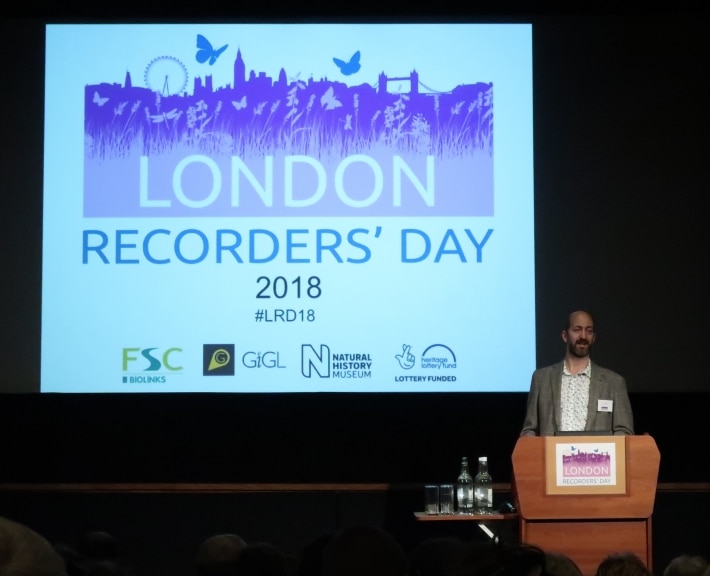
John Tweddle from the Angela Marmont Centre for UK Biodiversity welcoming everyone to the event
What was the first London Recorders’ Day all about? At its heart was a celebration of the people who care deeply about the wildlife in our capital. Its vision was to showcase the work of individuals, groups and organisations who, through wildlife recording, are making a difference to our knowledge of biodiversity, conservation of species and habitats, and enjoyment of living in London.
It may surprise readers to know that this was the first ever London Recorders’ Day, especially when there is such a long history of biological recording in Greater London. So, on the 10th November 2018, it was wonderful to see the Flett Lecture Theatre at the Natural History Museum packed to the rafters with people from across the diverse recording community, in what we hope will become an annual event.
As Chair of the event, Maria Longley, Community Manager at Greenspace Information for Greater London CIC (GiGL), guided us on our journey through the day. As well as introducing a wide variety of speakers and topics, she also provided the latest GiGL news including how we are working with a global network of volunteers to mobilse and transcribe the London Natural History Society (LNHS) historic paper bird records, through the Zooniverse project. She also gave updates on how we are making ecological information more accessible to more people through our website; Discover-London.
The keynote address was delivered by the “Urban Birder”, David Lindo. David is a broadcaster, writer, photographer and avid birder! With an interest in wildlife from an early age, and many years of wildlife recording under his belt, his boundless enthusiasm was as inspiring as his wealth of knowledge about recording. His passion for getting Londoners – in particular children and those of different ethnic backgrounds – involved in nature set the perfect tone for the rest of the day.
Stephanie West, UK Biodiversity Training Manager at the Angela Marmont Centre for UK Biodiversity, took us on a tour through almost a decade’s work supporting naturalists studying and recording British wildlife and gave us an exciting look at their plans to expand their services in the future.
Tristan Bantock, from the Terrestrial Heteroptera Recording Scheme, spoke about London’s True Bugs (Hemiptera). We found out that London has witnessed the arrival of many new species in recent years, making it one of the most exciting places in the world to record true bugs (though a less happy place for the beanstalks they are munching!).
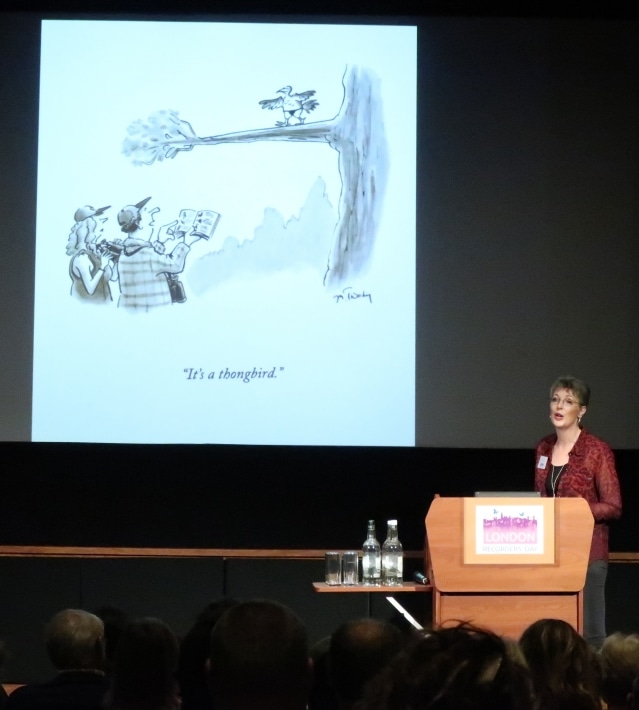
Allison Parkes presenting her talk about the Barbican Wildlife Garden
Allison Parkes’ talk, entitled “The Timorous Thong Bird (And Other Tantalising Secrets of a Wildlife Garden in the City)”, was fascinating, humorous and heartwarming. Allison is from the award winning Barbican Wildlife Garden, which has become an oasis for wildlife and people in the heart of the City of London. Getting the local community involved in recording the site’s wildlife has shown how important such pockets of wildlife are for London, and for educating and inspiring the neighbours. They take well-placed pride in shouting about what they find with the aim of reaching as many people as possible.
We were then brought back to the importance of inspiring the next generation by Russell Barnet, from A Focus on Nature, who delved into the grassroots work they do to support young conservationists in the early stages of their careers: sharing knowledge, skills and training. On a similar theme, Keiron Brown also gave us an update on the Field Studies Council’s London invertebrate identification project. We heard a summary of this BioLinks Project’s activities to date and had a peek at what is to come during 2019.
London Wildlife Trust’s Dragonfly Detectives project is an example of the power of citizen science. Petra Sovic Davies, Water for Wildlife Project Manager, told us how the project is using volunteers and the public to record the distribution of Odonata species across London.
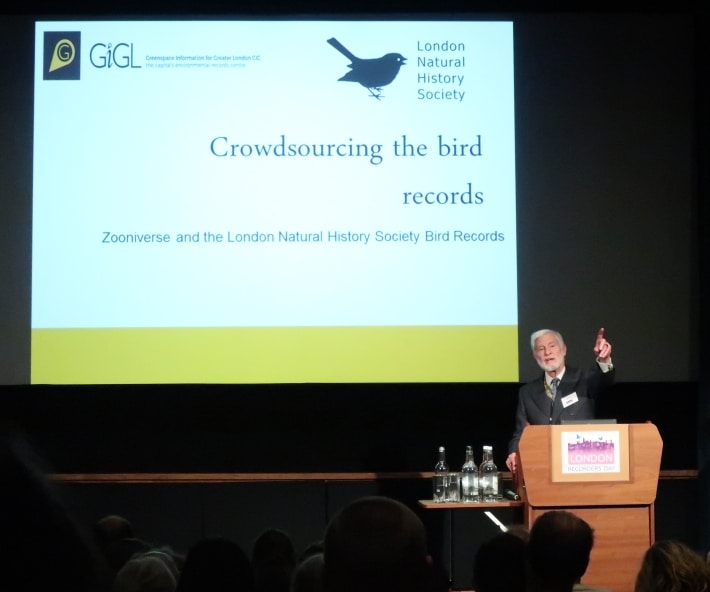
David Allen presents his work with GiGL to digitise LNHS bird records
Recording wildlife since 1853, it was appropriate that the London Natural History Society (LNHS) were then in the spotlight for three talks, given by Kat Dukes, David Allen and Leslie Williams – covering just a small but significant sample of their projects, including their work to populate London’s Butterfly Atlas and the latest Hampstead Heath Survey events.
The presentations finished with a talk from the Morus Londinium project charting the 2,000 year history of mulberry trees in the capital.
The day ended in a fitting way to celebrate the long history of biological recording in the UK and in London, its present and future. Participants were invited to sign-up to either a behind the scenes tour of some of the biological collections in the museum, explore the Angela Marmont Centre or attend a demonstration of the free QGIS tools available to support biological recording.
With reports of 60% of species disappearing from our planet, a London Recorders’ Day feels more important and relevant than ever. The partnership by GiGL, the Field Studies Council and the Angela Marmont Centre deserves a big thank you because the event they organised showcased the knowledge, expertise and enthusiasm at our fingertips in London through our recording community. What we can achieve together will make a real difference for the city’s wildlife, Londoners’ connections to nature and the health of our planet too.
Valerie Selby, GiGL Director
The last part of a very enjoyable and informative London Recorders’ Day afforded us the opportunity to take a peek behind the scenes at the Natural History Museum. Two different tours were offered and I took up the chance to have a guided tour around the Angela Marmont Centre for UK Biodiversity situated in the base of the Darwin Centre at the museum. I had visited before many times to use the visitor space but had never explored any further.
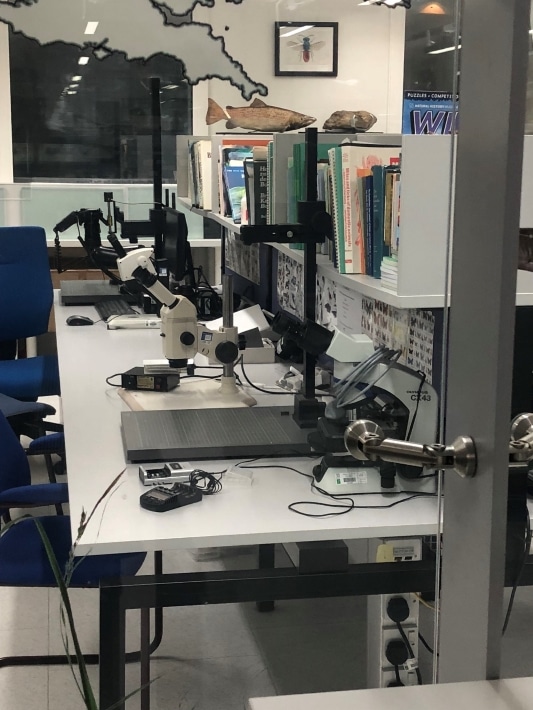
The self study area at the Angela Marmont Centre
The centre is home to ID and advisory services both for individual recorders and for commercial users nationwide. Staff can assist with advice about wildlife, fossils and other natural history specimens either face-to-face at the centre or at a distance. If however you wanted to work out for yourself what you have seen, there are a huge range of resources available in the self-study area – including technical wizardry such as “stacking cameras” for those tricky beasts that can only be determined one from the other by the most detailed of assessments.
The LNHS library is held here, available to any visitor whilst you are in the room but LNHS members are also permitted to borrow from this extensive depository of books, journals and papers.
There is a handling collection so you can directly compare your specimens and indeed this is a particularly fascinating resource for families, allowing children a close up view of the small, the fluttery, the fast moving as well as the unusual, all preserved for posterity in the dry collections room. This was perhaps the holy grail of the visit; vast collections of many species groups all gathered, displayed, labelled, and kept in a temperature controlled environment to prevent museum beetle. We saw examples from the entomology dry collection including dung beetles, butterflies and moths, but we walked past the British and Irish Herbarium to get to it and I’m sure there was more beyond. There is a freezer facility here large enough to accommodate a stuffed rhinoceros on a plinth (that probably being the largest thing they will ever need to freeze!).
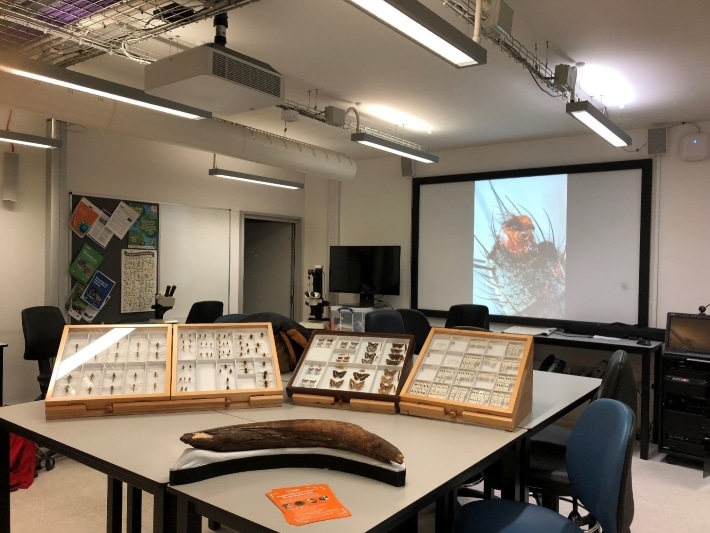
The visitor space at the Angela Marmont Centre
Once we prized ourselves away from these wonderful specimens, we then ended by hearing about some current projects the team here are involved with, including an exciting project investigating eDNA and the useful new sawfly ID guide they have published.
The visitor space is very flexible and can accommodate groups or individuals wishing to further their ID skills, use the available resources, including microscopes linked to AV screens to share what you are viewing, and lastly but by no means least, use the phenomenal expertise of the staff in the centre. Around 1,000 people a year already visit and benefit from this centre but they are keen to welcome more.
